Top 8 Superfood Smoothies You Should Eat Every Day to Lose Weight

Smoothies are a great way to meet your daily requirements for fruit and vegetables. So why blend instead of juice? "By consuming blended fruits and vegetables instead of juices, we can retain the fiber found in these foods instead of removing it as juicing does," according to Penn State Extension. "This leads to less food waste and increases satiety, or fullness, compared with drinking fruit and vegetable juices. Fiber is also a beneficial nutrient for digestive and heart health, which many of us do not adequately consume." Here are eight superfood smoothies you should eat every day to help with weight loss and overall health.
Blueberry Banana Smoothie
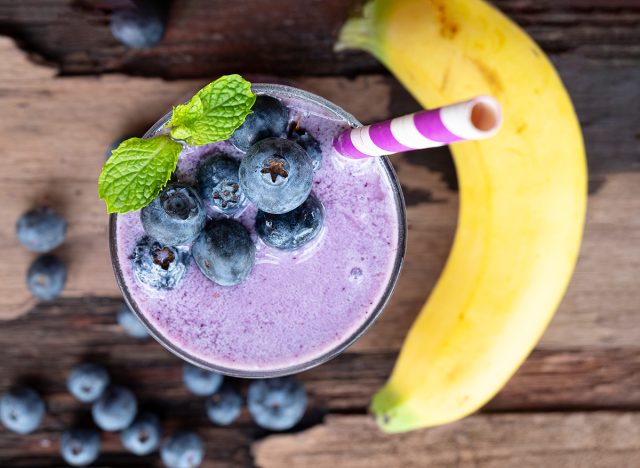
Blueberry Banana Smoothie
- 1 frozen ripe banana
- 1/2 cup frozen blueberries
- 1 cup skim milk
Serves 2. Each serving contains about 122 calories, 5 g protein, and 3 g fiber.
"When you make your own at home with ingredients that meet your nutrition needs and taste preferences, smoothies are a great way to get protein, fiber, and other nutrients," dietitian Jordan Spivak tells Johns Hopkins Health. "The great thing about smoothies is how versatile they are."
Triple Berry Protein Smoothie
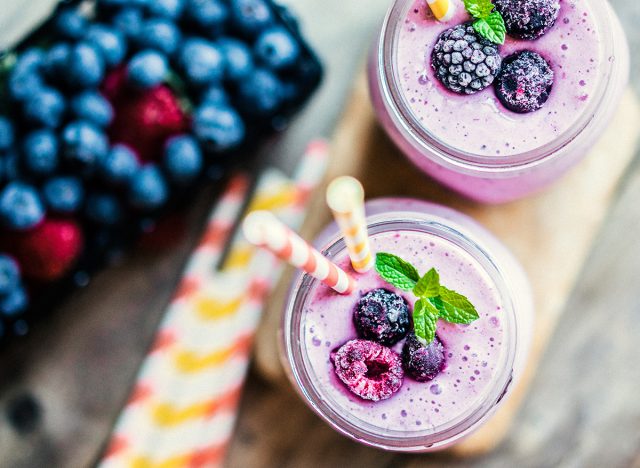
Triple Berry Protein Smoothie
- 1 cup unsweetened almond milk
- 1/2 cup fat-free, plain Greek yogurt
- 1 teaspoon stevia sweetener
- OR
- 2 stevia sweetener packets
- 1 squeeze mixed berry-flavored stevia water enhancer
- 1/4 cup fresh or frozen, unsweetened blueberries
- 1/4 cup fresh or frozen, unsweetened raspberries
- 1/4 cup fresh or frozen, unsweetened strawberries
Serves 2. Each serving contains about 78 calories, 7 g protein, and 2 g fiber.
"Raspberries, blueberries, strawberries and other berries add a sweet and tart flavor, and their fiber helps you stay full," registered dietitian Anna Taylor tells the Cleveland Clinic.
Tropical Green Smoothie
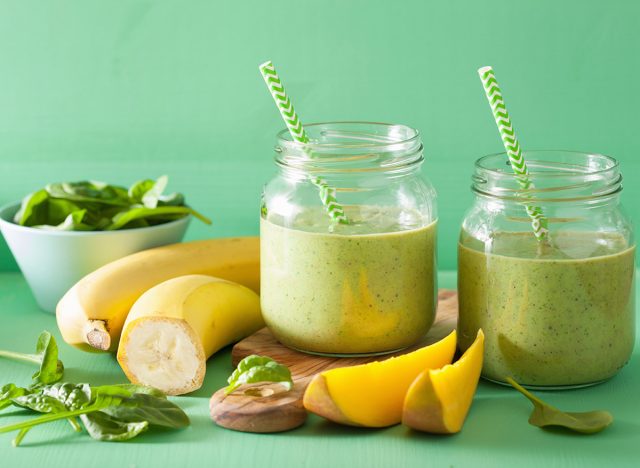
Tropical Green Smoothie
- 2 handfuls spinach
- 1 cup coconut water
- 1 tablespoon flax seeds
- 1 teaspoon honey
- 1 medium orange
- 3/4 cup frozen mango chunks
- 1/2 medium banana
- 2 cups ice
Serves 2. Each serving contains 168 calories, 3 g of protein, and 6 g of fiber.
"Spinach is one of the most nutritious foods you can eat," registered dietitian Kayla Kopp, RD, LD, tells the Cleveland Clinic. "It's also very easy to use. Raw or cooked, spinach is great in salads, appetizers, smoothies, and main dishes."
RELATED: 20 Superfoods for People Over 50
Avocado and Coconut Refresher Smoothie
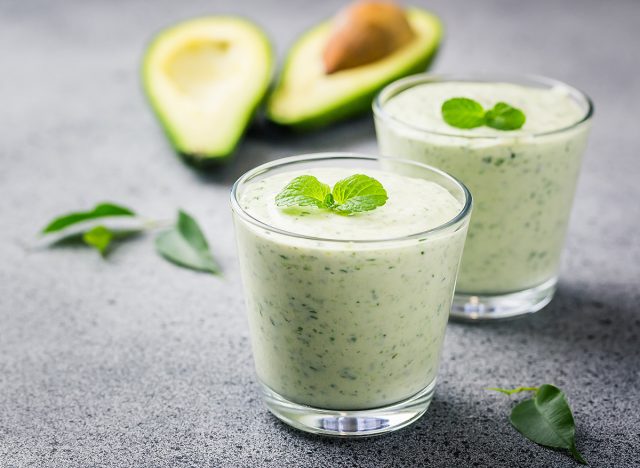
Avocado and Coconut Refresher Smoothie
- 2 small avocados, peeled and pitted
- 3 cups unsweetened almond-coconut milk
- 3 cups frozen mango cubes
Serves 4. Each serving contains 241 calories, 3 g of protein, and 9 g of fiber.
"Avocados are no regular fruits. They're nutrient-dense with very little carbohydrates and high amounts of healthy fats and fiber," says Frank Hu, Fredrick J. Stare Professor of Nutrition and Epidemiology at Harvard T.H. Chan School of Public Health.
Green Tea Berry Banana Smoothie
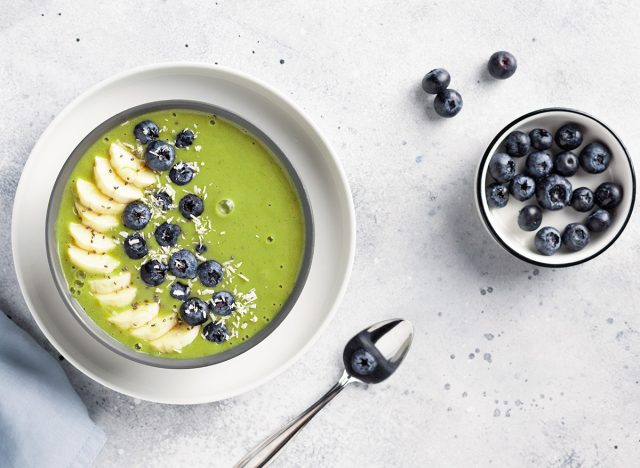
Green Tea Berry Banana Smoothie
- 3 cups water
- 8 single serving bags green tea
- 16 ounces frozen mixed berries (about 3 cups)
- 2 medium bananas (peeled, cut in half, frozen)
- 1 cup fat-free, plain Greek yogurt
- 2 teaspoons fresh, grated, peeled gingerroot (optional)
- 2 teaspoons vanilla extract (optional)
- 2 teaspoons chia seeds (optional)
OR
- 2 teaspoons flax seeds (optional)
Serves 4. Each serving contains 136 calories, 8 g of protein, and 5 g of fiber.
"Clinical studies suggest that green tea extract may boost metabolism and help burn fat," according to Mount Sinai.
Peach Melba Smoothie
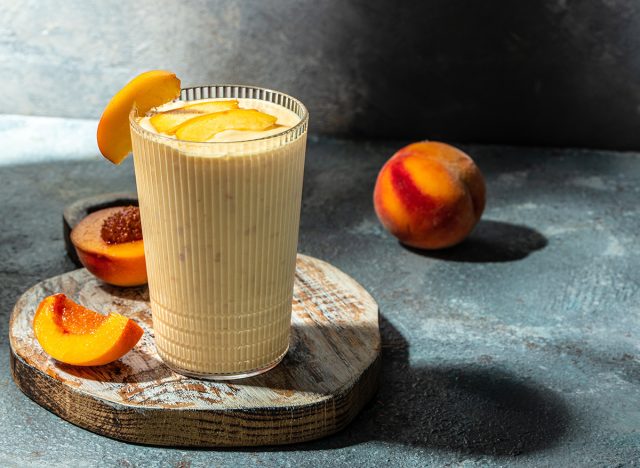
Peach Melba Smoothie
- 1 cup sliced peaches, fresh, frozen, or canned (drained and rinsed)
- 1 cup fat-free vanilla yogurt
- 1 cup crushed ice
- 1 cup fresh or frozen unsweetened raspberries; reserve 6 berries for garnish
- Mint leaves (optional), for garnish
Serves 2. Each serving contains 150 calories, 7 g of protein, and 5 g of fiber.
"Peaches contain both soluble and insoluble fiber," Maxine Smith, RDN, LD, tells the Cleveland Clinic. "Soluble fiber helps stabilize blood sugar and keeps cholesterol levels in check. Insoluble fiber aids in digestion and helps prevent constipation."
Berries and Spinach Smoothie Recipe
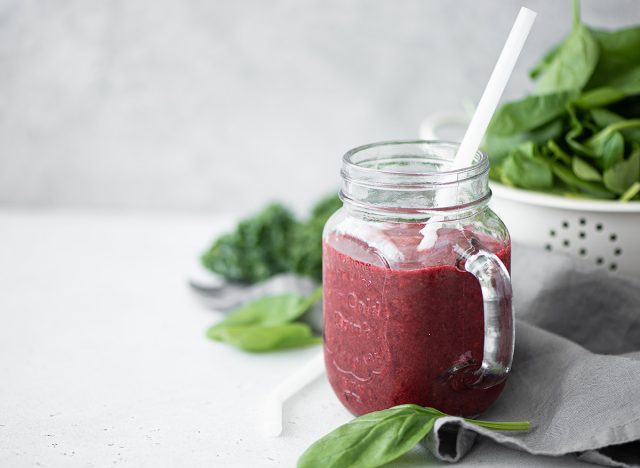
Berries and Spinach Smoothie Recipe
- 2 cups frozen unsweetened strawberries
- ½ cup blueberries
- 1 banana, peeled and cut in chunks
- ½ kiwi, peeled and sliced
- 2 cups fresh spinach
- ½ cup ice cubes
- 1 cup fat-free milk
- ½ cup 100% apple juice
Serves 4. Each serving contains 100 calories, 3 g of protein, and 4 g of fiber.
RELATED: Dave Asprey Reveals the 11 Secrets to Supercharged Energy Every Day
Creamy Kiwi-Lime Smoothie
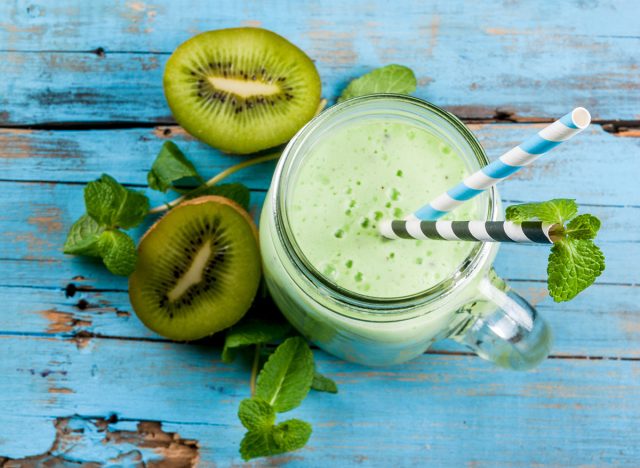
Creamy Kiwi-Lime Smoothie
- 1 1/4 cups unsweetened almond milk
- 3 1/2 ounces organic silken tofu, drained
- 2 kiwis, peeled and quartered
- 2 tablespoons creamy raw cashew butter
- 2 tablespoons hemp seeds
- Juice of 1 lime
- Optional: 1/2 teaspoon no‑alcohol, gluten-free pure vanilla extract or unsweetened vanilla powder
Each serving (2 1/4 cups) contains 500 calories, 19 g of protein, and 8 g of fiber.
"With all the wonderful benefits tofu can bring to your smoothie cup, you won't be disappointed!" says the Cleveland Clinic. "It's a plant-based complete protein, meaning you'll get all the amino acids your body needs and can't make on its own." And if you enjoyed this article, take advantage of these 15 Quick Ways to Lose Body Fat Percentage in a Week.




